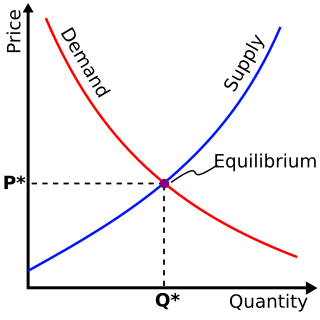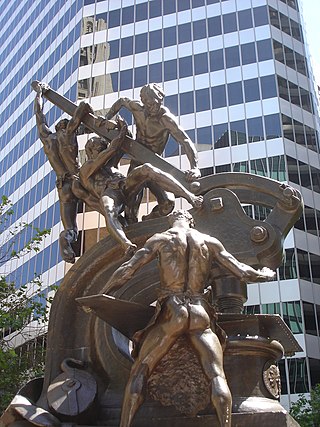
A social class or social stratum is a grouping of people into a set of hierarchical social categories, the most common being the working class, middle class, and upper class. Membership of a social class can for example be dependent on education, wealth, occupation, income, and belonging to a particular subculture or social network.

In political philosophy, the means of production refers to the generally necessary assets and resources that enable a society to engage in production. While the exact resources encompassed in the term may vary, it is widely agreed to include the classical factors of production as well as the general infrastructure and capital goods necessary to reproduce stable levels of productivity. It can also be used as an abbreviation of the "means of production and distribution" which additionally includes the logistical distribution and delivery of products, generally through distributors; or as an abbreviation of the "means of production, distribution, and exchange" which further includes the exchange of distributed products, generally to consumers.

Karl Marx's theory of alienation describes the separation and estrangement of people from their work, their wider world, their human nature, and their selves. Alienation is a consequence of the division of labour in a capitalist society, wherein a human being's life is lived as a mechanistic part of a social class.

Social class in the United States refers to the idea of grouping Americans by some measure of social status, typically by economic status. However, it could also refer to social status and/or location. The idea that American society can be divided into social classes is disputed, and there are many competing class systems.

The middle class refers to a class of people in the middle of a social hierarchy, often defined by occupation, income, education, or social status. The term has historically been associated with modernity, capitalism and political debate. Common definitions for the middle class range from the middle fifth of individuals on a nation's income ladder, to everyone but the poorest and wealthiest 20%. Theories like "Paradox of Interest" use decile groups and wealth distribution data to determine the size and wealth share of the middle class.

In sociology, the upper middle class is the social group constituted by higher status members of the middle class. This is in contrast to the term lower middle class, which is used for the group at the opposite end of the middle-class stratum, and to the broader term middle class. There is considerable debate as to how the upper middle class might be defined. According to sociologist Max Weber, the upper middle class consists of well-educated professionals with postgraduate degrees and comfortable incomes.

Social stratification refers to a society's categorization of its people into groups based on socioeconomic factors like wealth, income, race, education, ethnicity, gender, occupation, social status, or derived power. It is a hierarchy within groups that ascribe them to different levels of privileges. As such, stratification is the relative social position of persons within a social group, category, geographic region, or social unit.
In developed nations around the world, the lower middle class is a subdivision of the greater middle class. Universally, the term refers to the group of middle class households or individuals who have not attained the status of the middle or upper middle class associated with the higher realms of the middle class, hence the name.
Social position is the position of an individual in a given society and culture. A given position may belong to many individuals.
Life chances is a theory in sociology which refers to the opportunities each individual has to improve their quality of life. The concept was introduced by German sociologist Max Weber in the 1920s. It is a probabilistic concept, describing how likely it is, given certain factors, that an individual's life will turn out a certain way. According to this theory, life chances are positively correlated with one's socioeconomic status.
Though the American middle class does not have a definitive definition, contemporary social scientists have put forward several ostensibly congruent theories on it. Depending on the class model used, the middle class constitutes anywhere from 25% to 75% of households.

The American upper class is a social group within the United States consisting of people who have the highest social rank, due to economic wealth, lineage, and typically educational attainment. The American upper class is estimated to be the richest 1% of the population.
The social structure of the United Kingdom has historically been highly influenced by the concept of social class, which continues to affect British society today. British society, like its European neighbours and most societies in world history, was traditionally divided hierarchically within a system that involved the hereditary transmission of occupation, social status and political influence. Since the advent of industrialisation, this system has been in a constant state of revision, and new factors other than birth are now a greater part of creating identity in Britain.

Social reproduction describes the reproduction of social structures and systems, mainly on the basis of particular preconditions in demographics, education and inheritance of material property or legal titles. Reproduction is understood as the maintenance and continuation of existing social relations. Originally formulated by Karl Marx in Das Kapital, this concept is a variety of Marx's notion of economic reproduction.

Social inequality occurs when resources within a society are distributed unevenly, often as a result of inequitable allocation practices that create distinct unequal patterns based on socially defined categories of people. Differences in accessing social goods within society are influenced by factors like power, religion, kinship, prestige, race, ethnicity, gender, age, sexual orientation, intelligence and class. Social inequality usually implies the lack of equality of outcome, but may alternatively be conceptualized as a lack of equality in access to opportunity.
Marxian class theory asserts that an individual's position within a class hierarchy is determined by their role in the production process, and argues that political and ideological consciousness is determined by class position. A class is those who share common economic interests, are conscious of those interests, and engage in collective action which advances those interests. Within Marxian class theory, the structure of the production process forms the basis of class construction.

In sociology, the upper middle class of the United States is the social group constituted by higher-status members of the middle class in American society. This is in contrast to the term lower middle class, which refers to the group at the opposite end of the middle class scale. There is considerable debate as to how the upper middle class might be defined. According to Max Weber, the upper middle class consists of well-educated professionals with graduate degrees and comfortable incomes.
In Marxism, class consciousness is the set of beliefs that persons hold regarding their social class or economic rank in society, the structure of their class, and their common class interests. According to Karl Marx, class consciousness is an awareness that is key to sparking a revolution which would "create a dictatorship of the proletariat, transforming it from a wage-earning, propertyless mass into the ruling class".
Exploitation is a concept defined as, in its broadest sense, one agent taking unfair advantage of another agent. When applying this to labour, it denotes an unjust social relationship based on an asymmetry of power or unequal exchange of value between workers and their employers. When speaking about exploitation, there is a direct affiliation with consumption in social theory and traditionally this would label exploitation as unfairly taking advantage of another person because of their vulnerable position, giving the exploiter the power.
The proletariat is the social class of wage-earners, those members of a society whose possession of significant economic value is their labour power. A member of such a class is a proletarian or a proletaire. Marxist philosophy regards the proletariat under conditions of capitalism as an exploited class forced to accept meager wages in return for operating the means of production, which belong to the class of business owners, the bourgeoisie.










